Ron Hood with two Iraqi Engineers
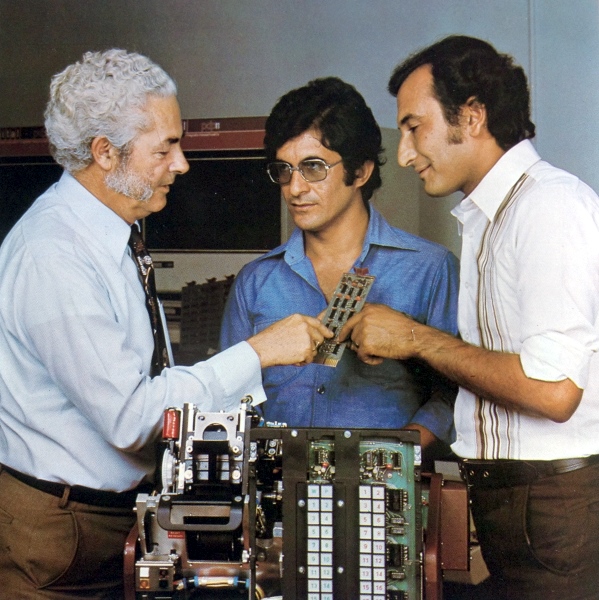
This is one of several pages relating to the history of the automatic totalizator, its invention in 1913, the inventor George Julius and the Australian company he founded in 1917 which became a monopoly in this field and later was a part of an oligopoly. If you wish to start from the beginning then go to the index
Three computerised betting systems worth a total of about US$4.5 million will be installed in Malaysia and Macau by ATL, the Australian totalisator systems specialist that ran into trouble last year at Hong Kong's Shatin race track.
Two separate systems will be installed at Penang and Ipoh race tracks worth a total of about US$2.8 million (M$6.1 million).
The system for Macau, the gambling oriented Portuguese territory across the Pearl River mouth from Hong Kong, will cost about US$1.7 million (P8.1 million) and is due to go live at the new trotting complex in May.
ATL is one of two Australian computer companies that can claim to be among the world leaders in their field. The other is Data Processing Customer Engineering the largest independent computer maintenance company outside the US.
Sydney-based ATL has been in the automated betting systems business a long while - in fact, it invented the business. The company has been in the news a lot in the last year and not all of it was good news. Asian Computer Monthly and Pacific Computer Weekly have twice shared exclusive reports on the company's problems with its state-of-the-art sell/pay wagering system that was originally meant for the Royal Hong Kong Jockey Club's new Shatin track. (Asian Computer Monthly, July and November, 1978)
The system ATL developed for the new track will now go into the RHKJC's Happy Valley track on Hong Kong Island. The company that has taken over the Shatin job, Amtote, actually started in the automated betting system by manufacturing an ATL machine under license.
But ATL general manager Tony Salmon claims the Shatin situation is not as black as it has been painted.
"It is not correct to say our Shatin system did not work - it didn't work on time and we could not meet the Shatin deadline," Mr Salmon said.
"That system works and, even though we had some problems with it, we now have the most advanced pay/sell wagering system in the world."
While attention has been centered on Shatin, many people have overlooked other successful ATL installations in Australia and Asia. Some of the contracts have enormous dollar value as many include operating contracts worth millions of dollars over several years.
Recent success at home for the company include:
So ends the Asian Computer Monthly article extracts. This is a curious place to finish this website as this article relates to the time when I started with the company. The article refers to two separate systems being installed at Penang and Ipoh. I started work in Ron Hood's Installation Department. It was there that I met Lachie Macdonald the Totalisator Engineer who would work on the Penang and Ipoh installations. It also mentions a system for the Combined Brisbane Racing Clubs which has gone live. This is the system that I worked on the development of and this project was a major career step for me and the Brisbane race tracks would provide a workplace for the rest of my working life. I also had a few occasions of working on the hardware of the Harold Park Trots totalisator, which is also mentioned in this article. I also met Kevin Franks, another Totalisator Engineer who would work on the Macau system mentioned above.
Bill Johnson, who I only met after the ATL era as he pre-dated my time with the company, remembers Penang and Ipoh in the following comment: I worked on Melbourne doubles installation 1960's, Caracas installation for three years and left to work in Kuala Lumpur, Penang and Ipoh between 1961-1967.
I am going to exercise a large amount of self control, as if I mentioned all the interesting people I met when first starting to work for Automatic Totalisators Limited, this would become voluminous. I am going to stay focused on the early Installation Department Engineers that I met. As mentioned, Ron Hood was the head of this department and was a veteran in this business. He possessed a mind full of company history which I thoroughly enjoyed listening to. I was very fortunate to have Ron as my first manager, as he set up a wonderful learning environment for me to absorb the engineering side of the company's products and the PDP11 computers that the transaction processors of our tote systems were based on. I thoroughly enjoyed my time in Ron's department soaking up the large amount of information made available. I have included the following image of Ron, this major mentor of mine, in his installation department in the ATL factory at Meadowbank, doing what he was so good at, training some engineers on our equipment, in this case engineers employed by one of our customers. Having mentioned Ron was a major mentor of mine, I have to make an exception to my sticking to the installation department engineers only and mention Bob Plemel, who was the Engineering Manager of ATL at the time, as he was another major mentor of mine in this company.
Ron Hood with two Iraqi Engineers

Neville Mitchell, wrote the following about the above image: The two Iraqi engineers were looked after by Ron hood, I had nothing to do with them, I recall that later it was rumoured they were ex security/army officers.
Another installation engineer I met was Bill York. He was working on the Sha Tin project at the time and consequently spent most of his time in Sha Tin, which is also mentioned in the article above. Bill was a Yorkshireman, as was my father. Ironically Bill was from York. I did not notice it during my personal contact with him, however I later discovered that when I talked with him on the phone, he sounded exactly like my father and it occurred to me that apart from the context of conversation, I would not have been able to discern which one I was talking to on the phone. Bill had an uncanny ability of performing an intense visual inspection of a faulty PCB to discover the slightest indication of a faulty component without engaging in any analytical fault finding process. Failed components often leave no visual indication of their failure, but sometimes they did and Bill would find the problem this way quicker than anyone engaging in a more analytical approach using test equipment.
I also met Alan Thomas who was working in the Philippines at the time and popped in for visits to the home base. I would later be sent with Alan on a trip to the United States to attend two courses, the first on an Okidata Disk Drive, which was held in Golita California and the other on the other side of the USA, on a Zylogics Disk Controller, used to interface the Okidata disk drive to the PDP11 computers, held in Boston Massachusetts.
Rex Turner, was the installation engineer for the Brisbane Project mentioned in the article above, which was the same project I was employed to work on the development of and ultimately move to Brisbane with as a totalisator engineer. About three and a half decades later, after Rex had left the company, I learnt that he is a knight. In December 2015 I met with Rod Richards and his wife Elizabeth for the first time, along with Neville and Nancy Mitchell. Rod was an installation engineer with Automatic Totalisators limited from an era well pre-dating mine, having installed the Julius Totalisator at Bundamba the year I was born. Rod and I had been communicating on the Internet with each other for many years prior and we quickly discovered we were both part time pilots. Ironically, during the meeting with Rod, Neville and I discovered that he knew Rex, as they had met at a Bowls Club and now play bowls together once a week. In their conversations together, they later discovered that they had both worked for Automatic Totalisators Limited. What they hadn't discovered, was that Rex was the installation engineer for the ATL computer based totalisator, which superseded the Julius totalisator at Bundamba, which Rod had installed 29 years earlier! In February this year, 2016, I spoke with Rex on the phone for the first time since he left Automatic Totalisators and dropped out of the ATL scene, some three decades prior. He has written about his experience working on the Baghdad system on-site, when war broke out. This is presented in the Memories of the factory continued chapter of this website under the heading Baghdad - Al Furusya Club - Al Mansur.
I also met Roger Penwarden, a charismatic ATL iconic engineer at the time and later, salesman and manager. I think he was working on a New Zealand project at the time. Roger invited me to assist him in repairing a paper tape punch, whilst I was with the installation department, which I found quite fascinating. I would have a lot more to do with Roger a few years later when he became the Branch Manager for the Queensland Branch. Now that we are both retired we both moved to the country and he and Sandy are only half an hour drive from where Narelle and I now live. Roger wrote the following about a difficult task he had to perform at ATL long after the photo above showing Ron Hood was taken: I have read through the information regarding the Installation department, seeing that picture of Ron Hood bought back lots of memories, some good and one bad. When I left Brisbane to return to Sydney I was the tote division GM, and not soon after I had the task of telling Ron he was to be made redundant, not the best of things any time, but having worked for Ron a number of years made it very, very, difficult for me.
I had many interesting conversations with Lachie Macdonald as he used to work for IBM and I enjoyed listening to Lachie relating his experience working at IBM. Lachie gave me some photographs of the Penang and Ipoh projects when we attended the ATL reunion dinner in December 2015, 36 years after the above Asian Computer Monthly magazine article was written. I remember attending a Christmas party at Lachie's place. Across the road from his house there was a vacant lot with a rather beautiful deep green plant growing all over it. I asked Lachie what the plant was, as it looked so attractive. He told me to stay right away from it, as the block was under constant surveillance by the authorities, as the plant was Marijuana.
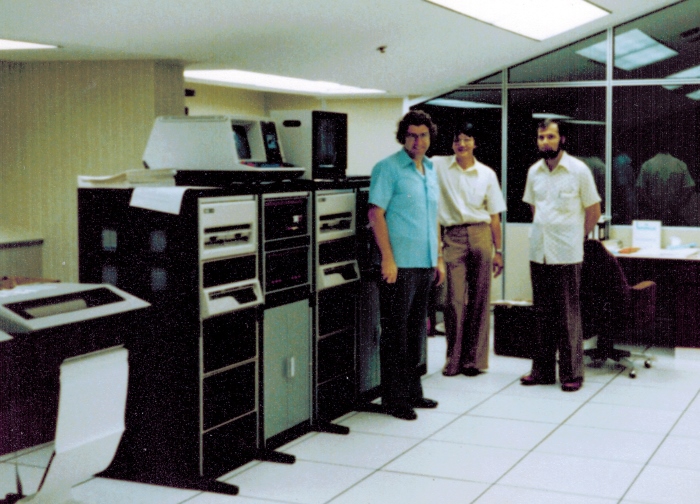 The Penang duplex PDP11/34 totalisator system
The Penang duplex PDP11/34 totalisator system
The above image is of the twin PDP11/34 based computer totalisator installed at Penang. Lachie Macdonald is on the left hand side with Yo Hung Ng from the Penang Turf Club and Rob Kessey also from ATL.
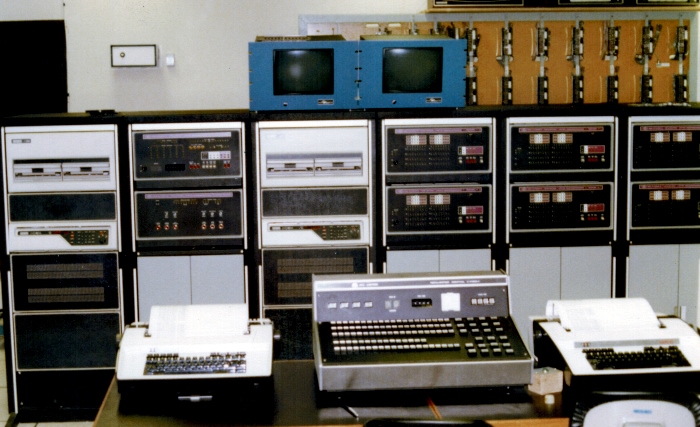
The above system was a temporary stop gap measure for Sha Tin. Similar sell only systems were installed in Ipoh and Penang which had sell pay systems as in the second image above, eventually installed, which functionally sat on top of the sell only systems.
Lachie Macdonald wrote the following about this project:
The Penang installation was the initial PDP11 sell only and followed the Ipoh installation. I installed both systems with Rob Kessey. Ron Hood did come up and looked after the re-cabling of the Indicator board. Both installations went well and opened on time despite considerable damage during shipment.The following year both Tracks upgraded to a Hybrid configuration, that included sell only and sell pay ticket machines. Rob Kessey was the software design engineer and after he decided to resign Bob Punch was given the task. Bob also resigned and Zis Francis took over. The issue was how to integrate the sell only TIM's into a sell/pay system. The solution was to write software that made the initial sell only system look like a J22 TIM. It worked! Rob Holgate, Dick Sterndale-Smith, Jeff Milvane, Nick D'Angelo, Ian Jordan, Peter Howe, lead by Bob Plemel solved the problem. I returned to Malaysia as the Project Manager and despite many, many hurdles the role, I thoroughly enjoyed.
So the final system for both Ipoh and Penang installations was configured with the Sell-Pay system treating the earlier sell-only system as a giant J22 consisting of 4 x PDP11/34s along with respective disk and tape peripherals. Both clubs retained all of their J8s and J10s (I think) purchasing 12 only of the J22s which were road freighted between the two clubs on race days. Now not sure what happened at KL, but when I left, ATL's bid for the upgrade was successful. Peter Howe and Malcolm Richardson at the time were KL (Kuala Lumpur) Jockey Club employees and did the evaluations of the three candidates, ATL, AMTOTE and AWA. I also recall many discussions with the Club Lawyer re the ATL Contract and the issues, the document was 2 inches thick and efforts to address were getting us nowhere - each rewrite from Meadowbank failing to grasp what the Club wanted - simplicity. The new GM John Wilkinson, who had previously worked in Asia came up to KL and on his return to Sydney a acceptable Contract did arrive. Again, this may reflect the attitude that existed within ATL leading up to ShaTin loss.
With AMTOTE and AWA snapping at ATL's heels, closing the KL upgrade and Sabah deals was a major success for me and ATL. I believe you managed the installations.
Following Malaysia came ShaTin and from January to the close of racing during the summer months I commuted between Sydney and Hong Kong supporting the PDP11 sell only system.
Lachie informed me that the above system was a hurried temporary sell only installation, to enable ShaTin to open on time. On the table in the foreground are two Teletype KSR43 console logging terminals one for each of the PDP11/34 processors. In between them is a hardware Race Day Control terminal. The Brisbane Project systems did not have these hardware Race Day Control Terminals, but used a specialised application running on a separate VDU (Video Display Unit) for each venue. The three racks on the right hand side contain scanners, devices that interface the old electromechanical TIMs (Ticket Issuing Machines) to the PDP11 digital computers, so that customers did not have to purchase a complete set of new ticket issuing machines when upgrading from the old electromechanical Julius tote to a computer tote. Prior to this new system, a Julius tote had been operating at Penang. Lachie provided me with a couple of photographs of the Julius Tote mainframe, which was being superseded by this system, however the poor lighting for the photo renders it unsuitable for display here.
Chris Robertson, the most totalisator industry knowledgeable high value punter I have met, provided the following Malaysian ATL system tickets as an adjunct to the above information.
Chris Robertson's tickets from Penang and Perak
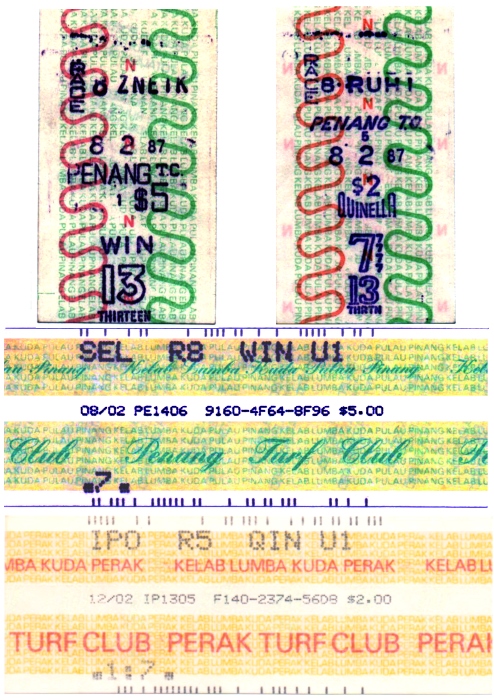
Chris Robertson wrote the following about the above Malaysian tickets:
The Malaysian/Singapore circuit comprised of four racecourses. The three I visited in the late 1980's were all ATL installations. Penang and Ipoh had J22 TIMs, and Singapore had the J25.The first three tickets are all from the same race. The race in question was run at Kuala Lumpur in Selangor state. These tickets are from the Penang racecourse phantom meeting betting on Kuala Lumpur. Each racecourse conducted its own pools back then. The win and quinella tickets have different race codes. The paper code runs down the middle of the paper rather than the sides. The bottom ticket is from Ipoh racecourse in Perak state, Malaysia.
Penang was the only place I saw J8 and J10 machines working alongside the J22. A Pay/Sell system with separate pay and sell windows depending on the ticket type.
Chris observes that J8 and J10 machines are working with J22s. The J8 and J10 machines are electromechanical and were designed for the electromechanical Julius Totes. The J22 is an electronic terminal designed to be used with digital computers. By the time Chris bought the above tickets, ATL had installed computer tote systems which superseded the Julius Totes. The top two of Chris' tickets were produced by a J8 and a J10 terminal respectively. The scanners mentioned in the paragraph below the image labelled The Penang PDP11/34 totalisator system interface these old electromechanical terminals with the new computer based transaction processors. This saves the club the additional expense of replacing all the old terminals with newly purchased electronic ones.
Note that, as Chris indicates above, the Perak Turf Club is in Ipoh. Following are some extracts from a Tote Topics Spring 1978 magazine article titled Perak Turf Club:
Ipoh is on the main trunk road and rail line midway between Kuala Lumpur and Penang. As the capital of Perak, it carries the title tin centre of the world.Ipoh is rich in shrines, many reminiscent of those found among the hills of distant Tibet.
One of the largest is Perak Tong, four miles south of the town. It has the biggest statue of Lord Buddha some 42 feet high in a sitting position, his four foot eyes gazing down from above.
THE PERAK TURF CLUB
Today's Perak Turf Club races on a fine course, the backdrop for which is Gunong Korbu, one of the highest peaks in the main range of the Peninsula. The club is the custodian of a Perak racing tradition that goes back nearly 85 years, the first meeting having been held at Taiping, then the State capital, in 1886 by the first Perak Turf Club. Its course was the cradle of racing in the Peninsula. ...... The last meeting under the Straits Racing Association rules before the start of the Pacific War was at Ipoh. There was, however some racing during the Japanese occupation. Webmaster's note: I find it amazing to think that even in war, racing was of such importance that any was allowed at all, particularly considering the ferocious tenacity with which the occupational forces conducted the war. ...
... The club is engaged on a development programme at its course. It has already a grandstand costing about $6 million. It is 500 feet long, 170 feet broad and the tower block is 175 feet high. It now holds 10,000 people but is being further extended. There are escalators, lifts, air-conditioned restaurants and bars. The grandstand extensions will cost $3,400,000 for the public stand and updating of the present stand. The new car park takes 600 cars. ...
... A new ATL computer Totalisator is being installed as stage 1 now. Stage 2 will be an upgrading with J22 terminals into a sell/pay system. ...
... Average attendance at race meetings 13-14,000 and for off course betting 4-5,000. Off course betting takes place when races are run in Singapore or other Malay towns. Catering and liquor supply is by concession and the club receives 15% on sales.
Take note of the definition of Off-course betting at the time, which is a little different to what is meant today. Today Off-course means the betting is being provided by an organisation that is not based at any particular racetrack. With the advent of digital computers, betting on meetings other than the one being locally run became comparatively simple. Today this would be called betting on another venue. Additionally if no local meeting is being held on the day as a result of it being abandoned usually due to rain, then this is called a phantom meeting rather than Off-course betting.
Chris Robertson provided the following additional information to my observation of "Off-course" betting:
The Americans use the word 'simulcast' to describe the activity of betting at a facility which is 'dark', i.e. not conducting racing on that particular day, but which is open to take bets on away meetings. This is distinct from wagering at an Off Track Betting parlour. It is unfathomable to anyone living in a country where the TAB has been so successful that the New York City Off Track Betting Corporation went bankrupt a few years ago. The other five New York state OTB corporations still wager on New York and other state's racing, just not in New York City. Bizarre.
Following are some extracts from a Tote Topics Spring 1978 magazine article titled Penang Turf Club:
Penang is an island of waving palm trees, glorious beaches and blue waters. you can be charmed by its scenic splendour and its multi-racial and kindly people. It has been described as the Pearl of the Orient. Only a two-hour jet flight from Bangkok, Penang is the Western Gateway to Malaysia. ...THE PENANG TURF CLUB
There has been organised racing in Penang for more than a century, the Penang Turf Club having been founded in 1864. ...The club received a free land grant in McAlister Road for its course of 7 furlongs 81 2/3 yards. Here the first stands and buildings of wood and attap were put up in 1869 and small annual meetings were started. At these the stake money was never more than $600 for the whole meeting. By 1898, Penang was holding two meetings a year, two days in January and two in July. Prize money for the year totalled $5,950. In 1900, new and substantial stands were built. These were to serve the club for nearly 40 years until the club acquired its present 230-acre site for $250,000 at Batu Gantong in 1935. ...
... The three-floor grandstand is of the most modern design, giving all seats a clear view of racing. There are excellent totalisator and other facilities and an infield indicator board. Racing can also be viewed from tea pavilions for members and Ordinary Members.
When the Pacific War broke out there were more than 100 horses in training at Penang. Largely due to the efforts of Mr. Ong Huck Lim, who was later president, racing managed to carry on between 1942-45. Webmaster's note: Like with Ipoh, I find this amazing.
...... The tote turnover is usually about $1 million at each meeting and the new ATL computer totalisator is being installed as stage 1 now. Stage 2 will be an upgrading with J22 terminals into a sell/pay system.
The Tote Room, off-course betting, Penang
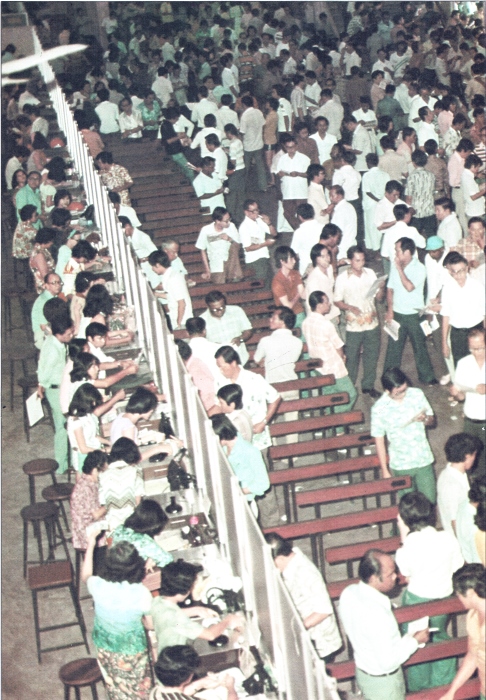
I do not know what year the above photo was taken so I do not know whether these machines are being driven by the Julius Tote or its successor the computer tote. It provides a good view of a big and busy tote house. The terminals in use here are J8s. As clearly can be seen the tote staff are on the left hand side inside the tote enclosure and the punters are on the right. The staff are organised into alternating sellers with their J8 TIMs and payout clerks. So far as I can determine it looks like there are 15 J8 terminals in this image.
Before leaving the context of the 1979 Asian Computer Monthly magazine article above and the failure of the Sha Tin project in Hong Kong, as well as the Tote Topics Spring 1978 magazine, I think it is pertinent to remember Peter Rolls, whose company eulogy appears inside the front cover of this Tote Topics magazine. As previously mentioned on this website, the company suffered a crippling loss in 1978 when Peter Rolls was murdered in Hong Kong. There were employees who firmly believed that the loss of Peter Rolls was the primary reason that the Sha Tin project failed. I remember Peter, although I was never introduced to him as there was never the time, as I only ever saw him in a hurry to dispense with the needs of his project at head office, so he could get back to where the action was in Sha Tin. My impression was that of an enthusiastic energetic objective-driven devoted employee. My parents were quite upset to hear this news, as we lived in Hong Kong and I was a schoolboy there and this sort of thing was totally unheard of in that city at that time a decade and a bit before this event.
Lachie Macdonald wrote the following:
The loss of the ShaTin business was a sad affair, and my personal view remains unchanged - that it should not have happened and would not have happened if Peter Rolls had not been so tragically killed.
After Shatin I left ATL and joined Sperry Univac in a Engineering Management position.
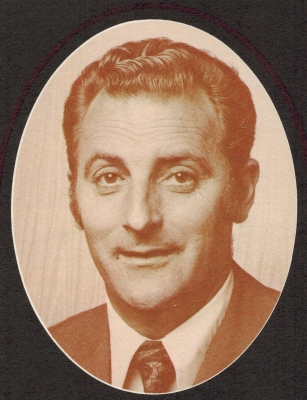
Bruce Rutter who is an ex General Manager of Automatic Totalisators Limited, wrote the following about the above segment and responded to my soliciting his opinion on having Peter Rolls' eulogy on the Internet:
It was of interest to me as I was involved in the training of the operational management of the Ipoh, Penang and K L installation. Also whilst the Sha Tin installation was happening with Roger Penwarden and Zus Francus we were in Teheran installing their new system which was quite successful except the Shah was about to be overthrown.Roger Penwarden, who originally worked for ATL in engineering and ended up the Tote Division General Manager, wrote the following when I solicited his opinion regarding whether there was a political correctness issue with presenting Peter Rolls' eulogy on this website: I am on the same page as you regarding Peter Rolls, It is nice to be remembered and I am sure his family would appreciate it.I am sure Peter Rolls' family would be quite happy to see his eulogy being part of your history. He was a great guy and we all have stories we could tell of being in his company. His son Peter worked with us at ATL during my time as GM. Peter would have been proud of him and he enjoyed hearing stories of his father.
I will never forget something my mother said when she was near the end and was aware of it: No one really dies until the last person who remembers them dies.
No examination of totalizator history would be complete without a mention of Oller. In 1865, Joseph Oller invented the “pari mutuel,” form of betting, which is the basis of the tote where investors bet against each other not the operators. In 1868 he lodged the patent for the first totalisator. He had two major business interests, horse racing and entertainment. He was a co-founder of the Moulin Rouge. He created a facility to print race guides and betting tickets. Slates on the sides of horse drawn wagons in those days were used to record horse names and odds offered.
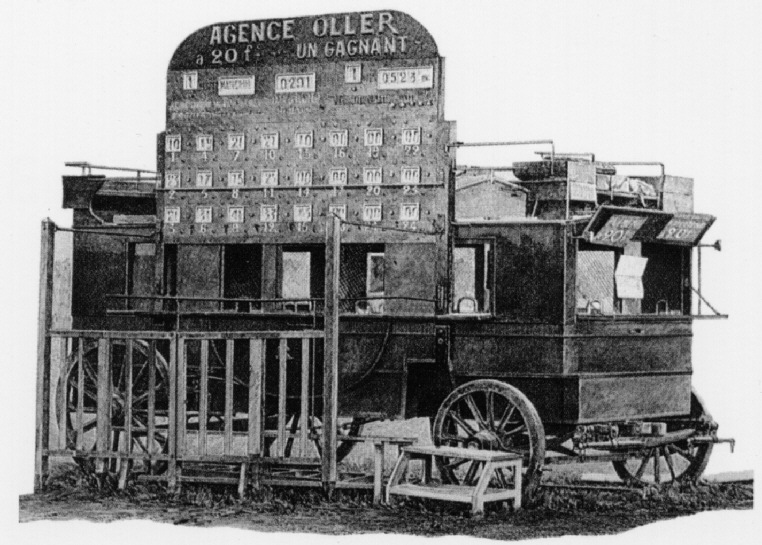
Oller's tote company was called CPM (Compagnie du Pari-mutuel). I met Jérôme Carrus CEO of PMC (Périphériques et Matériels de Contrôle) and CPM in October 2008 whilst visiting Paris and he kindly presented me with copies of PMC's book Pari Mutuel L'Aventure D'une Grande Invention Française and gave me a tour of his factory. I met Pierre Carrus the Manager of PMU and Andre Ville a PMC board member and former Technical Director. Jérôme and his father Jacques took my mother, wife and I for an extremely enjoyable lunch. PMC replaced the Julius tote at Longchamps with a computer system in 1973 after it had been working for 45 years. Jacques Carrus and Andre Ville were particularly interested in the Julius tote at Longchamps. PMC donated parts of the Julius tote to the Musée des arts et métiers after it was decommissioned. There are links to this museum and the PMC website in the links table below.
There has been a temporary link to Automatic Totalisators in France since the Insatiable Moloch. In 1994 the French company SEPMO (Société d'Exploitation du Pari Mutuel Oller), a supplier of wagering systems and services to the French off-track betting network and other customers was acquired by Autotote and became Autotote France. Autotote was the American Subsidiary of Automatic Totalisators.
Whilst in Paris I was determined to see if there was any remnant of the Julius tote, or "The Insatiable Moloch" as a Paris newspaper described it, at Longchamps. Jérôme in conjunction with PMC employees who were knowledgeable about Longchamps determined that there were no remnants at the track. This did not deter me from wanting to see the building that housed The Insatiable Moloch. At the time of my visit the Prix De L'Arc De Triumphe had recently been run and there were no race meetings for the duration of my visit, which meant I would not be able to enter the track as it was locked up. I underestimated the size of the Bois de Boulogne. I thought I would hop off the tour bus at the Arc de Triomphe and take a leisurely stroll down to Longchamps. I think the Bois de Boulogne must be the largest park area within a major city. It was a lot longer walk than expected and when I arrived I took the following photograph through the perimeter fence on quite a misty day.
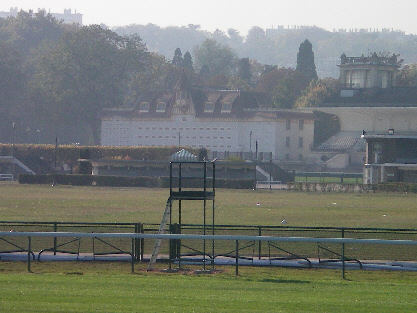
After having lunch with Jérôme an event occurred that I found quite moving. I recall seeing a modern day convertible transforming from a hard-top coupé to one, which looks like it was built without a roof, at the touch of a switch. I have not been impressed by a motorcar for a very long time, being more interested in motorcycles and aeroplanes, however I was quite impressed with the way this automatic transformation eliminated the roof without any trace of the car ever having had one. Jérôme's car is a convertible Volvo. When we were leaving the restaurant after lunch, Jérôme decided to drive home without the roof. As the car body was closing its final covers, that hide the openings into which the roof retracts, I heard a woman’s cry of amazement followed by some very rapid French. Looking in the direction of this voice I could see a woman on the far side of the pavement near a doorway to a building. She had a smile from ear to ear and she was talking excitedly with many hand gestures pointing in the direction of the car and performing emulations of the roof motion. She was talking to anyone who would listen in the street and even yelled up the hallway of the house. I did not understand what she was saying however it seemed obvious that she was exclaiming “did you see that” and describing the transformation of the car that she had just witnessed. I found it enormously uplifting to see an adult recapture some of that youthful spontaneous fascination and delight often experienced by children when they discover something new and exciting. It was obviously infectious, as it had brought a smile to the faces of bystanders witnessing this event as well as the occupants of Jérôme's car. It is a shame that these experiences of youthful exuberance fade, diminished by the years and the responsibilities and pressures of adulthood. As we drove off I heard her excited voice, still proclaiming this piece of adult magic, fade off into the distance.
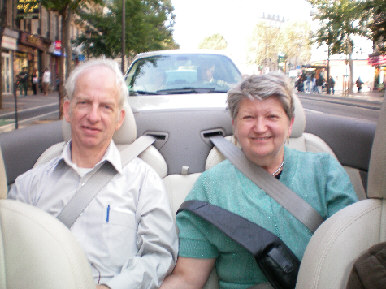
I also had to have a look at "Oller's Moulin Rouge". This is one of the best shows I have ever seen. The dancers are very agile and mobile on the stage, with ethereal garments that flow over the heads of the people sitting right up against the stage. When we sat down next to the stage we placed some items on a shelflike section attached to but lower than the stage to which the dinner table was abutted. We were asked to remove these items as the dancers would be using it. The pythons in the swimming pool were spectacular however I am not going to write any more as I do not wish to give away any trade secrets.
Prior to visiting Paris I met Charles Norrie and Danny Hayton in London. Charles is a member of GLIAS (Greater London Industrial Archaeological Society) and Danny is the treasurer of GLIAS and the Newcomen Society. Charles is an expert on the subject of George Julius and his totalizator and has an article in The end of an era - Harringay chapter of this website. Charles drove Danny and I to the London Science Museum's backup stores at a disused WW2 airfield at Wroughton. We were able to see parts of the Harringay Julius tote and other Julius tote equipment from Wembley and Newcastle. Brian Bradfield, a conservator at the Museum was extremely helpful in finding the Julius equipment within the vast expanse of stored exhibits. Brian and his assistant Neil even offered to bring a palette of equipment with parts of a marble tote down from the fourth story level of a storage rack if we wanted. Brian also gave us a tour of the whole facility, which was fascinating; the only problem was we should have had days to do the collection justice. Some of the items in this museum were very interesting. There was even a part of a particle accelerator, a technology I would have thought to be too new to have pieces in a museum store.
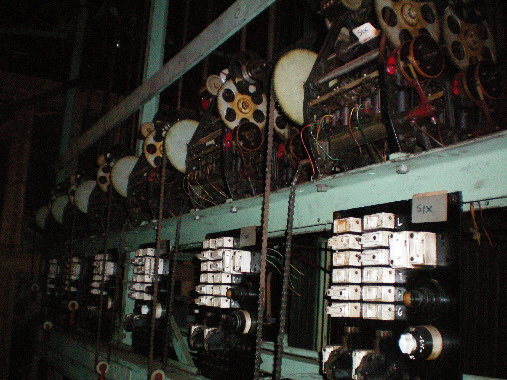
Charles invited my travelling companions and I and his next door neighbour Chris Rule for dinner at his home. We had a congenial and very entertaining night. Charles is an excellent cook and every one of the seven courses he presented was delicious. After enquiring about a particular sauce we discovered that Charles is something that I believed to be long extinct, a Tudor Cook. King Henry The Eighth would have been quite at home with us. Evidently this is an art that is still kept alive today.
I spent a day with Charles, Danny and other members of GLIAS visiting Bletchley Park to hear the story of Alan Turing and the WW2 code breakers, which was very interesting and a story in itself. The members of my family, do not understand why I "waste time" reading signs, particularly ones conveying history or how something works. I found it quite unusual to find I was amongst a group of people who read signs. These were "my kinda people". Danny had been working to establish the National Computer Museum in the Bletchley Park complex, of which he gave us a personalised tour. They had an old PDP11 system which was used for Air Traffic Control Radar processing and display. It reminded me of my early tote years and I was asked if I could repair their high-speed paper tape reader. Nostalgia, if I only had the time!
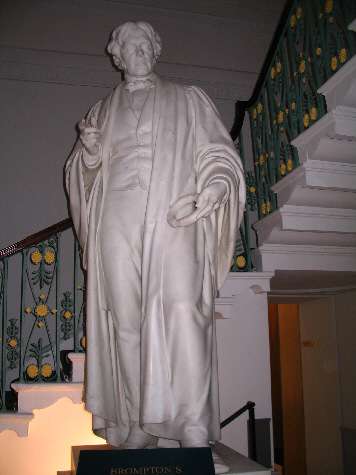
I noticed from the tourist maps that the Faraday Museum was not far from where we were staying in Mayfair. I could not resist seeing a museum dedicated to the "Father of electronics". The Museum had just been transformed from the Faraday Museum to The RI or Royal Institution where science meets the world and Faraday conducted his experiments. It had not opened at the time I visited and the exhibits downstairs were closed however I was kindly allowed to walk through the floors open for pre opening functions. The electro-mechanical Julius totes would not have been possible without the principles of the induction ring Michael is holding in his left hand in the image above. Without discovering these principles there would have been no generators, motors, solenoids or transformers. I think this sentence is probably superfluous however if there are any technologists scratching their heads about Faraday, I suggest they contemplate the origin of the unit of capacitance.
In 2009 I returned to London and revisited the Royal Institution which was then open. I had a look down stairs at the exhibits of Michael's experiments and laboratory. It was all fascinating. The electromagnets are recognisable however items like the first voltmeter and first electric motor bear no resemblance to what they are today.
We stopped in Dubai for two days on the way over and five days on the way back. My mother, wife and I had never been to Dubai previously. I could write a lot here about the contrast of old and new and the massive scale modern development with world leading achievements however it would be a diversion from totalizator history. I will sum it up and state that it is very impressive and mention that I saw large banner promotions for a competition to win a trip to Dubai at Doomben racecourse before my departure to Dubai, which stated that it was the place where the world's first horse race took place. It is also the home of the world's richest horse race the Dubai Cup. Don't miss the Desert Safari!
In 2016 Narelle and I spent three months on holiday in Germany and the UK. I have presented Michael Faraday above, who is significant in the history of technology and discovered the electrical foundation principles that made the post mechanical totalisator history as presented in this website possible. It seems appropriate to include here another such character, who made the digital computer era of totalisator history as exists today possible. In this example we have a lot older character however, making his contribution from the 17th century rather than the 19th century, as in the case of Faraday.
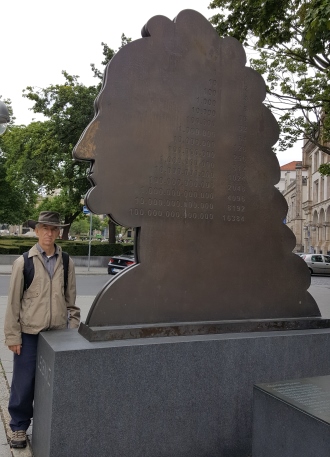
During our visit to Germany, I had an amazing revelation in Hannover. I have known the name Leibniz for a long time. Erroneously I had always thought of him as a composer and philosopher. I stumbled upon a metal silhouette of his head, a monument which I recognized as I had seen his face on the sides of trams. His face was associated with advertisements which were part of the Who was Leibniz campaign. I was astonished when I came close to the silhouette and could read the engraving on it. I immediately recognized it as the decimal equivalents of a binary one shifting left in a word. I could not imagine what the binary numbering system had to do with someone who was born in 1646! I had always presumed that the binary numbering system had been invented in the 20th century, which I now know is not the case. On reading the associated descriptive text I discovered Leibniz devised the binary system so long ago! I also discovered that Leibniz was a mathematician and an Engineer amongst many other things.
Some people were born long before their time! A pity Leibniz had no idea what he had discovered, nor of digital computers or the massive revolutionary digital computer industry based on his binary system, with its wide sweeping impact on most people on the planet, which is probably changing our evolution.
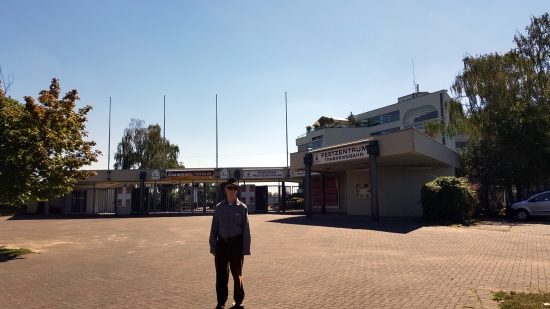
And now, back to totalisator history! In Berlin we popped down to Mariendorf Trabrennbahn (Mariendorf Trots). Automatic Totalisators Limited's American subsidiary company Autotote installed a system there in the 1980s. There are tickets from this trotting track on this website in the Tote Topics chapter. Despite my slow German language, I was extremely pleased to find that the managers I spoke to there, although busy, were very interested in their club's history and in talking to me. They were well aware of the background of the Autotote system and were interested in the connection and significance of Automatic Totalisators Limited. I was astonished when they informed me that the Autotote system was still operating. 32 years of operation is a long lifespan for a computer tote system! In addition to the previously mentioned Mariendorf tote tickets in another page on this website, there is an Autotote article on Bahrenfeld Trabrennbahn, where another Autotote system was installed in neighbouring Hamburg. For this reason, I have included the details regarding this visit to Mariendorf in the Tote Topics chapter, which can be read by selecting the Go to the index option in the navigation bar at the bottom of this page and selecting the Tote Topics chapter in the index. You will find it under the heading Mariendorf Trabrennbahn Germany - Autotote System. I have included a link to the Mariendorf website in the links list below associated with the image of me standing outside the entry gates to the trotting track.
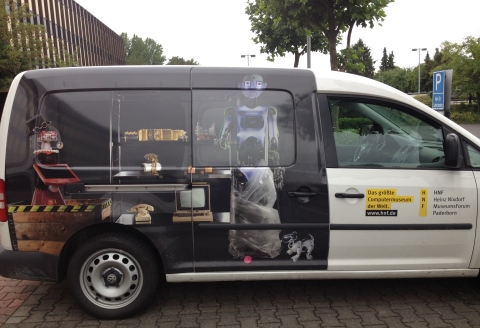
Another place of interest from a technology and computer history perspective was the Heinz Nixdorf Museums Forum HNF in Padeborn. The slogan of this Museum is The largest Computer Museum in the world, which can be seen written in German and highlighted in yellow on the passenger door of the Museum vehicle above. Unfortunately it was closed for renovations on the day we visited and the days we were in the vicinity. We took some photos of the museum building and some of the colourfully painted museum vehicle which was parked in the Museum car park. In the image above, one of the museum's vehicles is shown with part of the museum building in the top left. The painting on the vehicle shows a blue standing robot with the lower half covered in bubble-wrap on the right and a red robot on the left with the upper half protruding above a packing crate, amongst other exhibits. The blue robot gives a masculine impression whilst the red robot gives a feminine impression not only because of the colours but as the latter seems to be wearing a dress and bodice. The blue robot seems to be gesturing to a robot dog on the ground, probably K9, which is facing a red ball at the feet of the blue robot. The red robot is holding a computer screen with what looks like the letters MET2A on the frame. I think MET2A is a gene, if it is a manufacturer name I am not aware of it. I get the impression there is something very human about this scene. I have included a link to this Museum's website, which is in German, in the links table below.
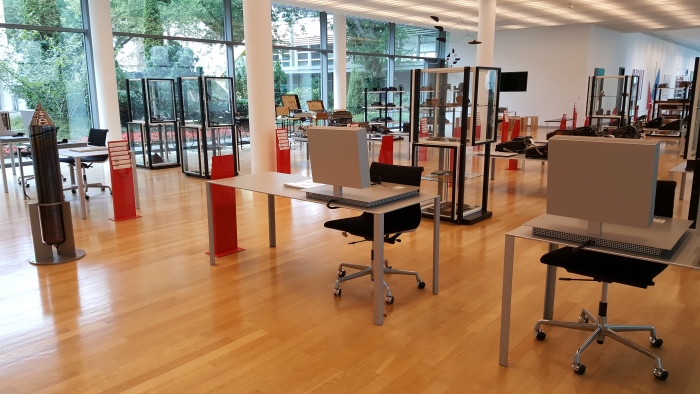
Later, in Bonn we saw the extremely impressive Arithmeum which was open. This is a museum based on mathematics and houses a collection of 1200 calculators, mechanical, electromechanical and computers. It houses the most comprehensive collection of historical calculating machines worldwide. I managed to conjure up sufficient German to talk to the attendant at the museum. He told me that what was on display was only a small part of the collection which included another 10,000 items not on display. I introduced him to the subject of totalisator history which he seemed to be quite interested in despite being busy. I sometimes wonder about my relatively obsessional interest in the history of technology, however when I see museums like this, I realise that I am just a beginner.
The image above shows a small section of the Arithmeum. It contains an interesting contrast. In the foreground there are two computer tables with chairs. Looking at the top left corner of the computer screen on the right hand computer table, immediately to the left and further behind is a display table with a few old purely mechanical calculators on it. Looking closely, you can see two silver handles on the two nearest mechanical calculators on this table contrasting with the black bodies of the calculators. The right hand calculator, which partly disappears behind the near computer screen, has its silver handle sloping up to the left at about 45 degrees. The handle on the calculator to the left of the one just mentioned, can be seen near the left hand side of the calculator sloping down to the right from the pivot point at about 20 degrees to the table top. These handles provide the motive force to activate their respective calculators.
On the left hand side of the above image, you can see a tall grey cylindrical object standing on the floor, in total contrast to the mechanical calculators. It seems appropriate that it looks like a rocket as it is the material that explosively accelerated calculation of all kinds to dizzying heights. Basically this is a block of silicon semiconductor material which is used to manufacture the functional part of electronic integrated circuits or ICs commonly known as chips. ICs provide the means of motionless and silent calculation in very small packages. The sign accompanying this display reads: 200 mm Silizium-Einkristall - This monocrystal consists of 99.9999999 pure silicon. Cut into wafers, it forms the basic raw material for the production of chips. And yes, this is the sort of Silicon that gave Silicon Valley its name. In my time in electronics engineering, I had a brief initial period of predominantly making measurements in timescales of milliseconds then microseconds and finally nanoseconds.
The Arithmeum even has exhibits of one of my favourite memory implementations, core memory. Although the last time I worked on core memory was about 35 years ago, I can still draw a functional diagram of the core stack and its interface electronics. This is something that computer and human memory have in common, both can store information that has not been relevant for a very long time.
The Arithmeum also has some interactive mechanical displays which allow you to crank exhibits through operating cycles to see how the calculations are performed which is far more intuitive than the electronic counterparts. The orange stands distributed around the displays in this image contain descriptions in a variety of languages. I have also included a link to this Museum in the links table below.
Whilst in Germany, Narelle and I made a detour to Hungary to meet my cousins Dagmar and Manfred for the first time. They are a married couple, who oddly enough are both related to me, one through my grandfather and the other through my grandmother. We spent a couple of exciting days together with my cousins, who provided a grand tour of Budapest and then Manfred drove us to the resort they own and run at Lake Balaton, where Narelle and I had a delightful break from the hustle and bustle. Their extreme hospitality was unbelievable and Narelle and I had the time of our lives together with them. Narelle and I were treated to a sumptuous breakfast and other refreshments each day with Dagmar and Manfred, at their dining table situated outside their front door in a garden setting. The weather was perfect every day. As with most of our holidays, apart from having a good time, we also have an agenda relating to one or more of the subjects, George Julius history, totalisator history, or the history of technology. By the time we got to this part of the trip we had already ticked off the four items presented above and expected to be free of these objectives at the resort. That covers the setting and now we get to the facetious point of this story.
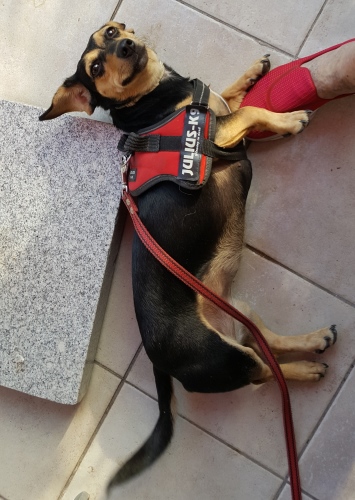
From the breakfast table it is possible to see Dagmar and Manfred's driveway gate and anyone walking past the gate on the street. One day, when we were sitting at the table, an elderly man with a little dog on a leash was strolling past. Unexpectedly the man stopped as a kerfuffle broke out. The man was pulling on the leash and the dog was not moving. He then tried talking to the dog to coax it to keep walking. He tried picking the dog up, whilst trying to convey the necessity to keep moving. The dog however struggled and squirmed in his arms in an attempt to be returned to the ground, which it soon achieved. The man's verbal attempts to get the dog moving increased along with his stress level. Now Dagmar intervened, announcing in a raised voice so the man could hear, that it is OK and that he should let the dog come in. The man replied that he could see she had company and that he did not want to interrupt. With the dog on the ground again, the man returned to the pull the dog with the leash method. The dog in an almost sitting posture with legs braced against forward motion in a stiffened stance was ever so slowly scraping along the pavement as the man uttered I don't know what's happening it's never done this before. By this time Dagmar was opening the gate, ushering the pair inside and insisting they come in. The man, realising that his action with the dog was untenable, resigned himself to the fact that the dog had won and the pair entered the garden. Manfred explained the dog was used to getting a treat at their place and that is why the dog wanted to come in. As the dog received its customary treat Dagmar and Manfred had a chat to the man, who was permanently renting one of their houses. I could not believe my eyes when I looked down at the dog which was now lying near the breakfast table. It was wearing a coat with writing on it. It read Julius K9 which seemed like a message for me. I was having a break from matters to do with George Julius and I was looking at a bizarre reminder that I had more to do. Just in case I did not get the message that I was the intended recipient, the other letters on the dog's coat were also pertinent to me as I am a Doctor Who fan and I recognise K9 as the Doctor's trusty robotic canine companion. To top it all off, the dog seemed to be knowingly staring up at me in such a fashion as if to say they think I did it for the biscuits but you and I know I did it to deliver this message. This event brings to mind the saying you can run but you can't hide.
As this is a links page, here is a link to Dagmar and Manfred's resort website PLATTENSEE-NORD.DE. We will definitely be returning there! I know you will think me biased, however family ties aside, Narelle and my dispassionate opinions are the same, that they are excellent hosts that attend to every detail.
There is more information relating to this trip in the George Julius Genealogy and other latterday interest chapter of this website under the heading Germany and Britain Holiday 2016.
 Links to related sites
Links to related sites

| Flight | Destination | Comment |
|---|---|---|
| 1 | Don McKenzie's tote recollections | This link represents a continuation of the Totalizator History saga related in this Web Site. Don McKenzie has recorded some of his experiences gained whilst working for Automatic Totalisators in Victoria for a quarter of a century. Some things never change! Don recalls the call for a "mechanic" when something was wrong with the tote. Thirty one years after the final operation of the Julius totes in Queensland, I still hear the odd call for a "mechanic" instead of a "technician". |
| 2 | Don McKenzie's Dontronics | After Automatic Totalisators Don started his own electronics company. |
| 3 | The World's First Automatic Totalizator | Professor Bob Doran's excellent research on the world's first Automatic Totalisator installed at Ellerslie in 1913. |
| 4 | YouTube video clip 1 YouTube video clip 2 YouTube video clip 3 YouTube video clip 4 YouTube video clip 5 YouTube video clip 6 | Raw footage of an interview conducted by Racing Queensland in the Eagle Farm Racing Museum: 1 Introduction to George Julius and his totalisators 2 Interview continuation - Describing the Shaft Adders 3 Interview continuation - Describing the Odds Calculators 4 Interview continuation - Describing the Front End system 5 Interview continuation - Describing the Ticket Issuing Machines 6 Interview continuation - Discussing the PDP11 system that replaced the Julius tote |
| 5 |  | A bastion of the contemporary totalizator |
| 6 | 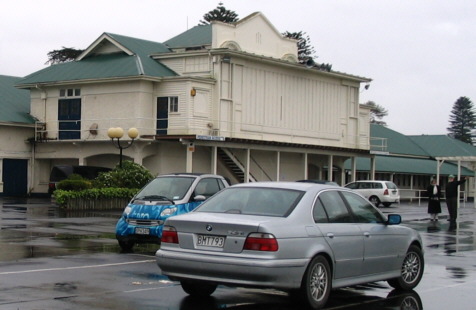 | Ellerslie Racecourse.The world's first automatic totalizator commenced operation here on Saturday 22nd of March 1913. Further Julius installations were performed in 1918 and 1922. I visited Auckland in 2007 and Prof. Bob Doran gave me a tour of totalizator history sites including Ellerslie. I took photographs of an old tote building that housed a Julius tote at Ellerslie. There were ornate windows which used to house the display counters from a Julius tote. The wall containing the counter windows, the highest peaked part in the photo, is now an inside wall as the building has been extended at some time. This building is different to photos of the original 1913 building. I found an old photograph of this building without the extension and compared it with one of the original 1913 tote building. Both photos have a similar orientation and both have a hill in the background with sufficient characteristics to deduce with reasonable certainty that they occupy the same location. Consequently the original building must have been replaced or undergone significant alterations. |
| 7 | 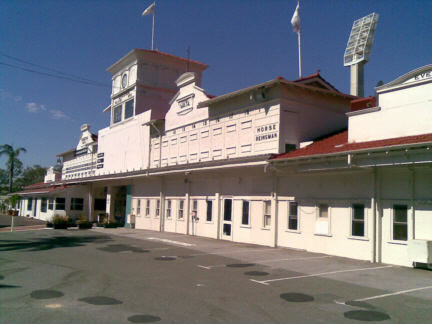 | The first automatic totalizator in Australia was installed here at the Western Australian Trotting Association Gloucester Park in 1916. Another Julius Tote was installed for the WATA in 1929. The first floor level of the building shown in this image was the Julius tote machine room. The slots below the runner numbers on the first floor provided a public view of the runner total counters installed in the machine room. Automatic Totalisators invented the world's first odds computer in 1927 and after that year Julius totes displayed the odds instead of the runner totals. The central tower housed the pool total display and manually driven dividend display. The Club Management was very obliging and I was shown over the old Julius Tote Machine rooms. This was not as straight forward as it sounds. In the case of the one in the photograph, as I have observed at other locations, there is no fixed staircase to this level. A metal retractable staircase has to be lowered by electric winch to gain access to this level. The view of the tote in the image is from the inside of the trotting track and the light post towering over the building is at the neighbouring WACA. This photograph was taken in 2011 and the Julius Tote machinery is all long gone. The only remnant was a solder terminal block still attached to a wall with the stubs of removed cables still attached to it. |
| 8 | 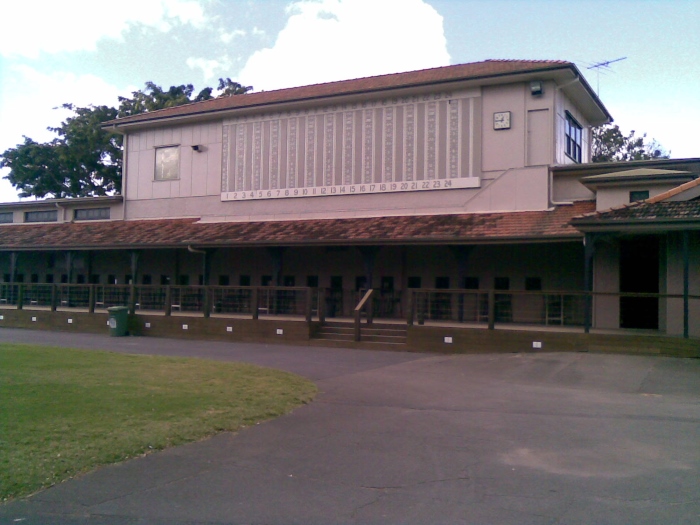 | The second automatic totalizator in Australia was installed here at the Brisbane Racing Club (Queensland Turf Club at the time) Eagle Farm Racecourse in 1917 and was followed that same year by the installation at Randwick. There was a second new generation Julius Tote installed in this building circa 1948. The barometer indicator visible on the side of this building is part of this second Julius tote that ceased operation in 1979. Julius totes displayed odds as seen here after Automatic Totalisators invented the world's first odds calculator in 1927. This old behemoth electromechanical totaliastor system still exists in-situ in this building and is the centrepiece of the Eagle Farm Racing Museum. There is a whole chapter of this website dedicated to the Julius tote inside this building. To read about it, select the Go to the index button in the navigation bar at the bottom of this page and then select the Eagle Farm Racecourse Museum chapter. This photograph was taken in 2011. |
| 9 | 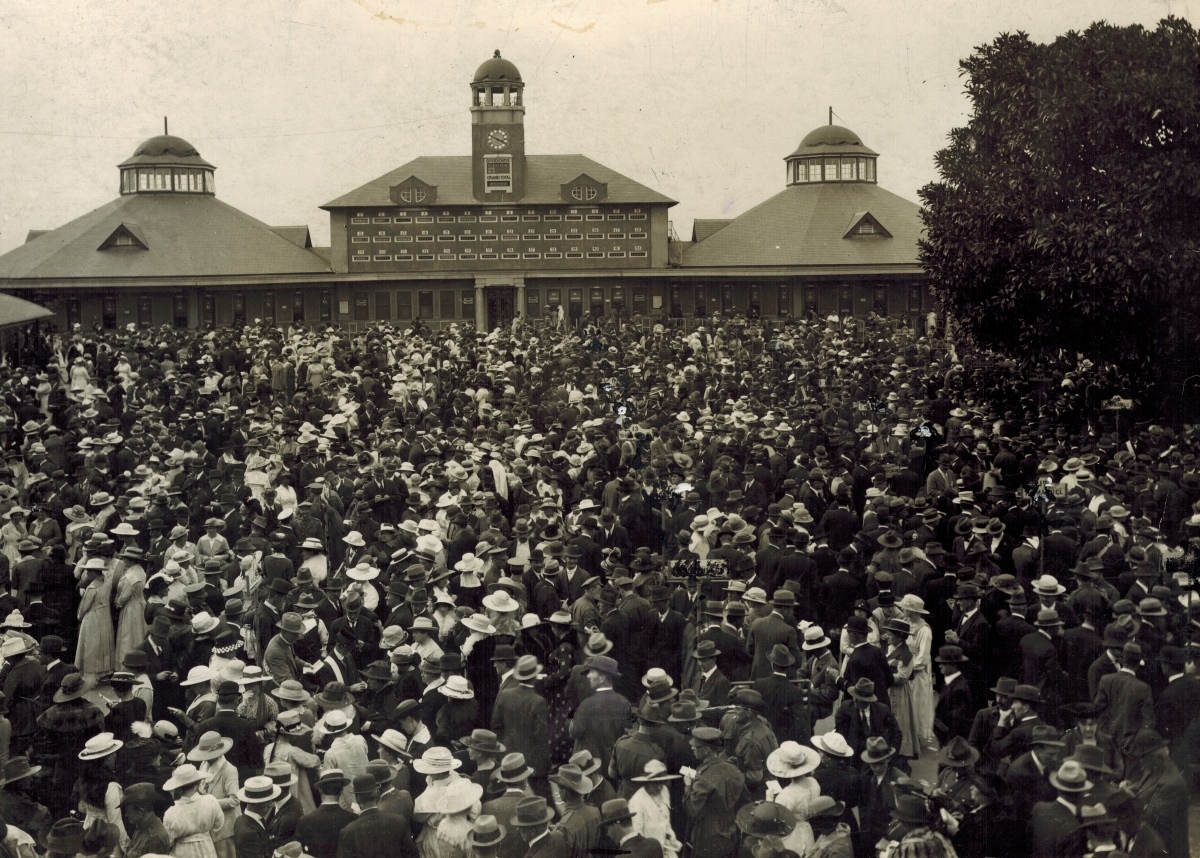 | Randwick Racecourse. Julius tote installations were performed at Randwick in 1917 with 150 terminals and 1935 with 113 terminals. The 1917 installation was the third in Australia. This Paddock building was purpose built for the tote. The photo shows the kind of crowds the Julius tote had to contend with. It is still in use today (2013) by the tote, not for ticket issuing machines however. To see following installations have a look at the Installations / Testimonials - The Premier Totalisator chapter in the index which can be viewed by following the Go to the index link at the bottom of this page. |
| 10 | 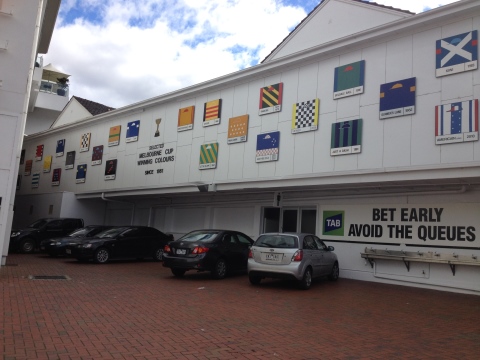 | This is an image of the Julius tote machine room at Flemington. I took the photograph in August 2014 during a visit to Melbourne when I had a wonderful reunion with people Chris Robertson, the most informed punter on the subject of totalisators I know, wrote the following about this building: |
| 11 | The 1963 Melbourne Cup | A Youtube video clip by Noel Leeder, which shows the running of the cup. Chris Robertson who sent me this link wrote: It is interesting from a tote perspective because it shows Flemington's barometer indicators, and the totalisator house within which the Julius tote was situated (Paddock 'A') |
| 12 | Opening Day Hialeah Park 1932 | This is a Youtube video clip uploaded by Kevin Martin. It has short segments showing the newly installed Julius tote in operation in Miami in 1932. It shows tickets being sold at the TIMs (Ticket Issuing Machine) and the tote mainframe in operation and some action taken on the TCC (Tote Control Console) as well as views of the indicator boards. |
| 13 | New York Racing Association | The world's first computer totalizator was installed here by ATL. |
| 14 | The Queensland History of Racing website | Some anecdotes I provided to Racing Queensland on the history of totalisators in Brisbane. |
| 15 | Charles Norrie Talk on Julius | An edited version of a talk given by Charles Norrie on the Julius tote to the Computer Conservation Society at the London Science Museum on 25 March 1993 titled George Alfred Julius and his Automatic Totalizator |
| 16 | The Australian Science Archives Project's, Bright Sparcs | George Julius reference |
| 17 | Powerhouse Museum DHUB archive | Unpacking Design, with reference to Julius Poole and Gibson, George Julius' engineering consulting company |
| 18 | Tote model Powerhouse Museum Archive | George Julius' Automatic Totalisator demonstration model, the object of an ABC National Artworks, Jewel In The Crown series, interview with Matthew Connell Principal Curator at the Powerhouse Museum on the 5th April 2009 |
| 19 | Powerhouse Museum article | An article on George Julius with images of his tote model and Ellerslie |
| 20 | Powerhouse Museum model railway engine | A model in the Powerhouse archive of a Pacific Class engine which was probably part of a model city produced by George Julius. There is some discussion of this in the George Julius Genealogy chapter of this website under the heading An email from Bill Chalmers. George's interest in model steam engines is understandable considering he graduated with a BSc in Mechanical Engineering specialising in railway engineering. |
| 21 | Powerhouse Museum Julius Tote fragment | A working section of the Julius tote from the Broadmeadows Racetrack near Newcastle |
| 22 | Matt Giuca's visit to the Precision Dynamics Discovery Shed | The Discovery Shed exists to encourage thinkers and tinkerers. Matt Giuca's visit focuses on Babbage's Difference Engine Recreation by Bob Moran. Bob also built Interactive Julius Tote Displays here. |
| 23 | Museum Of Victoria Julius adder collection item | Prof. Bob Doran sent me a link to this Julius adder in the Museum of Victoria. It looks like two shaft adders coupled together. Some discussion relating to this adder took place including Neville Mitchell and Don McKenzie. This discussion was oriented around identifying the adder as a horse adder or a grand total adder. |
| 24 | Another Museum Of Victoria Julius adder collection item | Whilst I had a look at the above Museum of Victoria link I noticed a related item which was a shaft adder I donated to the Museum a long time ago. |
| 25 | The Rutherford Journal | The First Automatic Totalisator - Note: It is ironic that George Julius appears in the Rutherford Journal as Ernest Rutherford and he were students together at the Canterbury College (University) both starting in 1890. See the George Julius Genealogy chapter for more on Canterbury College George and Ernest |
| 26 | The Rutherford Journal | An Unlikely History of Australian Computing: The Reign of the Totalisator |
| 27 | The Australian Dictionary of Biography | A George Julius Biography |
| 28 | The Kings Candlesticks: Pedigrees | A Genealogy site by Edward Liveing Fenn which presents George Julius' family amongst many others |
| 29 | An Encyclopaedia Of New Zealand 1966 | This is an entry for Julius, Most Reverend Churchill who was George Julius' father |
| 30 | The Virtual Museum of Computing | |
| 31 | Charles Babbage Institute | Web Sites Related to the History of Information Processing |
| 32 | Victorian Racing Museum | |
| 33 | Australian Computer Museum Society | |
| 34 | ECHO: Exploring and Collecting History On-line | Science and Technology |
| 35 | Australian Computer Society | Graeme Philipson's Ebook titled A Vision Splendid The History of Australian Computing |
| 36 | Computer Conservation Society | |
| 37 | Yesterday's Office | |
| 38 | Harness Racing in Australia | |
| 39 | 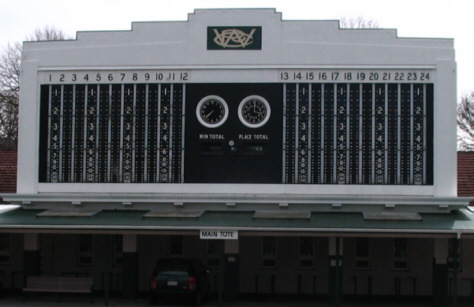 | Trentham Racecourse. In September 2007 I visited New Zealand on holidays. I took some photos of Trentham racecourse which is near Wellington. Julius tote installations were performed here in 1920 and 1936. It was a delight to see the old tote building in an excellent condition. So often historical equates with dilapidated which is the opposite in this case as it is now in a better condition than in the historical photograph, taken in its heyday, in the Ex ATL meets Ex JP&G/photo gallery chapter, click on the first icon after selecting the link, to see the full sized image. Prof. Bob Doran from Auckland University has documented the Julius totalisator still present in this building. |
| 40 | 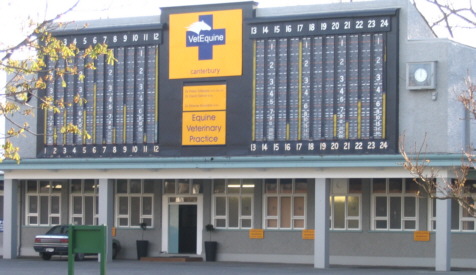 | Riccarton Racecourse. During the holiday mentioned above, I also visited Riccarton Racecourse in Christchurch. Julius tote installations were performed here in 1921 and 1935. Here too, it was a delight to see the old tote building in good condition. It is now occupied by a veterinary company. I spoke to one of the employees there and she was aware that the building used to be the main tote house and that it had historical significance. She indicated that the old Julius totalisator was still present upstairs. |
| 41 | MOTAT Museum | Museum Of Transport and Technology which I visited in 2007. Stephanie McKenzie indicated that MOTAT did have totalizator equipment listed as being amongst their collection however it is awaiting further research. It is not known whether it is the original machine from Ellerslie. |
| 42 | Paul Duffett's Greyhound Racing Archives | The Flame Photos archives are all encompassing when it comes to greyhound racing. From old stadiums, personalities, champion greyhounds or the good old days when stadiums were full we have it all. Paul's site includes photographs of Harringay, A London dog track that had a Julius Tote. The Harringay tote is a well covered topic in multiple pages in this totalisator history website. Paul has an entry in the accolades section of this site accessible via a link below the index and the index is accessible via a link at the bottom of this page. |
| 43 | CSIRO | George Julius was the first Chairman of the CSIRO or the CSIR as it was then known. The initial meetings of the CSIRO were held in a back office of Julius Poole and Gibson's premises, George's engineering consulting company based in Sydney |
| 44 |  | Mariendorf Trabrennbahn is a trotting track in Berlin Germany, where an Autotote computer based totalisator system commenced operation in 1984. I was surprised to find that the trotting club management were aware of and interested in the history of this Autotote totalisator system. I was very surprised when they informed me during my visit in 2016 that the Autotote system was still in operation. Autotote, previously known as Atusa, was the American subsidiary company of Automatic Totalisators Limited. |
| 45 | PMC/CPM | PMC the French tote development company that replaced the Julius tote at Longchamps in 1973 |
| 46 | Musée des arts et métiers | The museum where parts of the Longchamps Julius tote were donated by PMC when they replaced it with a computer totalizator |
| 47 | Brisbane History Statehood to Federation | The history of Brisbane Queensland in a pictorial and narrative format |
| 48 | Bill Bottomley's Cyberfiles | An extract from one of Bill Bottomley's very interesting What Did You Do For A Crust interviews with Danny Alexander appears in this website in one of the photo gallery image pages. On Bill's Cyberfiles page, click on the Words filing cabinet drawer and then select the What Did You Do For a Crust and the complete interview with Danny can be selected there along with several other interviews. |
| 49 | 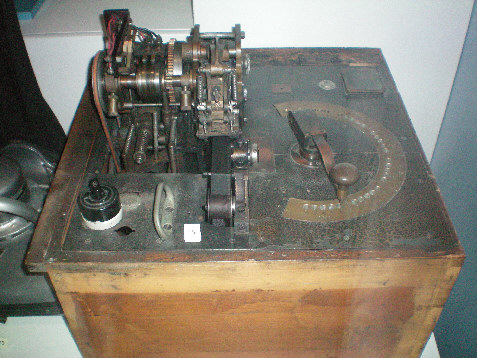 | The London Science Museum. In September 2009 I visited Britain on holidays again. I had a quick look inside the London Science Museum at Knightsbridge. This quick look was only due to time constraints resulting from having to return home prematurely due to an emergency. I could easily spend a week in this museum much to the disdain of the rest of my family who do not share my enthusiasm for such things. I found a Julius Ticket Issuing Machine from Harringay on display in the museum which is shown in this link. |
| 50 | Max Burnet's private computer museum | Max has established a private computer museum in his home. He is an inspiration to computer historians and makes me realise I am just a beginner in this field. |
| 51 | Max Burnet's private computer museum tote connection | And yes Max has a Julius tote shaft adder in his collection visible in the second row of thumbnails in this link. |
| 52 | The National Library of Australia's Historic Australian Newspapers site | Voluminous amount of articles on George Julius and Automatic Totalisators - just search for these keywords. |
| 53 | Bitsavers.org | PDP11/34 Engineering Print Set and Technical Manuals. This relates to the Computer Tote maintenance (technical) chapter of this website. |
| 54 | The Golden Pipeline A National Trust Project | Information on another Australian engineering achievement of C.Y. O'Connor who was George Julius' father in law |
| 55 | Racing and Sports article | May 1969 Edition of Turf Monthly relating to Automatic Totalisators |
| 56 | The Monash Museum of Computing History | A Julius Tote shaft adder was donated to this museum in February 2010. Additionally George Julius' engineering consulting company Julius Poole & Gibson designed and supervised work on all the electrical systems and associated services for Monash University from 1949 to 1966. |
| 57 | Hitmill History of Computers | This site includes the names of early pioneers of math and computing and links to related sites about the History of Computers, for further study. |
| 58 | 20th Century London Website | Professor Bob Doran sent me an email whilst I was in London in September/October 2010. It provided information regarding an exhibit, containing a part of the Harringay Julius tote that operated at the Harringay Greyhound Racing Track, at the Museum of London |
| 59 | The British Pathe Website | Professor Bob Doran sent me another email in 2013 with this link. It contains a video clip of a Julius tote in operation. The website's description reads The tote to be legalised. Exclusive pictures - taken specially for Pathe Gazette. It also mentions wonderful electrical Totalisator in use on Australian Racecourse. Sydney, Australia is also mentioned. Electrical Totalisator has been used on multiple occasions to describe the electromechanical Julius totes. The year of this video clip is given as 1927. This is the year before the installation at Longchamps and there are similarities with the Longchamps system. As Sydney is mentioned on the website in 1927, this could be either the Randwick or Warwick Farm Julius totes. Of particular interest is the paddle wheel inertia brake which can be seen at the left rear of the adder on display. As the units wheel of the investment counter used to rotate so fast during heavy betting, that the digits on the wheel were a blur, inertia had to be dissipated when the betting rapidly subsided. |
| 60 | WA Royal Commission on Betting | A copy of a West Australian report from a Royal Commission on Betting in 1959. Search the PDF file for references to Automatic Totalisators. There are references to this in the George Julius Genealogy and other latterday Interest Chapter of this website under the heading A Trip to Perth March 2011 |
| 61 | History Of Computing | Nathan Zeldes' very interesting site relating to his collection of slide rules and other historical computing artefacts |
| 62 | Contributions to the HIstory of Mechanical Calculation | The purpose of this website is to explain selected items and sections from the history of mechanical (instrumental) calculation with numbers. |
| 63 | Office Collectables | An impressive Spanish website on the prehistory of information including typewriters, calculators, function of mechanical calculating machines, patents and manuals. |
| 64 | History of Computers - Hardware Software Internet ... | A very interesting site with chapters on Dreamers, Calculating Tools, Mechanical Calculators, Charles Babbage, Birth of the Modern Computer, Internet and People by Georgi Dalakov. |
| 65 | Allan Bromley: historian, eccentric, gem | A Sydney Morning Herald eulogy for one of the greatest computer historians I know |
| 66 | Museum of Historic Computing Machinery | Includes Exhibitions, a Book Library and a Virtual Museum in French |
| 67 |  | A German language website for HNF - The Heinz Nixdorf Museums Forum in Padeborn Germany - The largest Computer Museum in the world. |
| 68 |  | The Arithmeum is a museum on the theme reckoning past and present. It houses the most comprehensive collection of historical calculating machines worldwide and presents the highlights of the history of mechanical computing in aesthetically attractive surroundings. |
| 1 | Oz Horse Racing | The A-Z of Australian Racing and Breeding |
| 2 | Horse Racing Links | Home of Australian Horse Racing |
| 3 | The Australian Racing and Breeding Homepage | Racing and Breeding on the Internet since 1996 |
| 4 | the-racehorse.com | Racing and bloodstock news, pedigrees, results and stallion statistics |
| 5 | Horse Stall Bedding | Elite Equine Shavings provides the highest quality pine wood shavings for horse stall bedding |
| 6 | Pro Group Racing Thoroughbred horse racing tipping service |
With all the interesting technology of these systems and the park-like workplaces, it is the people who bring it to life. Following is an article that I wrote which appeared in a TABcorp company magazine called "On Track" in June 2006.
Phil worked for Automatic Totalisators Limited in the 1980s performing component level maintenance on the J22 and J25 ticket issuing machines. The branch manager at the time said “if you ever want a bracket for something Phil’s your man”. I would go further and extend this to any type of gadget. Phil built a maintenance bay for his repair work, which looked like something that would be at home at NASA Control. I am glad that Phil returned to work for us, otherwise I would be feeling like the last of the Mohicans as we are the only two remnants of the ATL technologists who worked in Brisbane.
I recently suggested to Phil that he was like MacGyver. For those who have not seen this 1980s series on TV, it was about a former Special Forces agent dedicated to righting wrongs with ingenuity rather than brute force. I certainly felt that, although entertaining, it was implausible, as the movie magic would always provide him with nearby raw materials to provide a solution. Phil strikes me as the nearest I have seen to a real life MacGyver. Phil informed me that I was not the only one to call him that. He related an incident at a Gliding Club function when an expensive spit, which was to be used for roasting, suffered a seized gearbox in the last minute. Phil redesigned it with parts from an old wire spooling device and saved the day. He has since been known there as MacGyver.
Recently I was looking around for some means of keeping two sector panel aerials standing vertical on a flat surface. (Postscript :- our current tote has radio bridges to extend TIM LANs and access points for hand held terminals) I solicited Phil for some ideas. In true MacGyver fashion Phil darted around looking at available items. After a couple of minutes he uttered yep yep got it. He picked up the plastic ends of a cable roll, which had a central hub with plastic radial arms extending to a square plastic perimeter. In the blink of an eye and the whiz of an electric screwdriver the aerials were standing on their new bases, which looked like they were supplied like that from the manufacturer.
As you can see from the photos Phil has not lost any of his MacGyver attributes. Inspired by the electrician at Eagle Farm who had been darting around the track on his electric scooter, Phil soon had his own model, donated by a friend, probably repayment for some of Phil’s innovative services. He soon had a trailer attachment for moving tote equipment around, adapted from a wheelbarrow. More recent improvements have been a headlight, augmentation batteries, a detachable umbrella and a front carry box. Any of you wishing to place orders will have to talk to Phil.
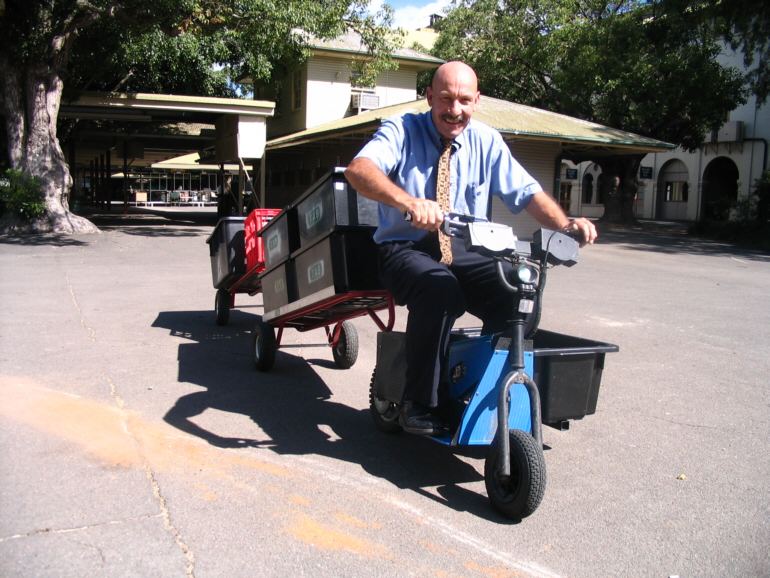
If Joseph Oller were alive today he may have said about this point in this website La Fin or perhaps C'est fini
I am a member of a small family and lived in "British Colonies" since the age of 9. Despite having enjoyed the "colonial life" for a long time now and at present almost 50 years later, I cannot escape the feeling of coming home when I visit the UK. It was nostalgic to be staying so close to Berkeley Square where the nightingale sang in the famous 1940 song A Nightingale Sang In Berkeley Square. I was overjoyed to meet up with my cousin and part of his family in October 2008. I was very impressed by his delightful granddaughter Hayley. She is 11 years old and recently wrote a poem for a school assignment, which she wrote down for me at a restaurant in Shepherds Market in Mayfair. Beyond being an excellent poem I felt it conveyed a poignant message worthy of proclaiming.
Earth
Litter flying all around
Carelessly thrown on the ground
Pollution in the air
Scientists in despair
People cutting down the trees
Levels rising across the seas
Polar bears swimming far away
In search of a place safe to stay
We feel our world getting hot
It's time to act ready or not
The best gift we get at birth
Is our lovely planet earth
Now we need to work together
To keep it safe forever
Hayley.
 Go back to the index
Go back to the index

| Previous page | Go to the index | Top of the page |